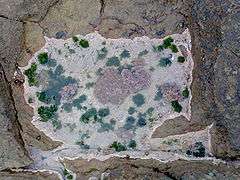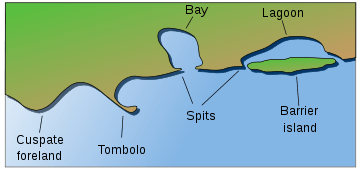Intertidal zone
| Marine habitats |
|---|
 The rocky shoreline of Newport, Rhode Island, USA showing a clear line where high tide occurs. |

The intertidal zone, also known as the foreshore and seashore and sometimes referred to as the littoral zone, is the area that is above water at low tide and under water at high tide (in other words, the area between tide marks). This area can include many different types of habitats, with many types of animals, such as starfish, sea urchins, and numerous species of coral. The well-known area also includes steep rocky cliffs, sandy beaches, or wetlands (e.g., vast mudflats). The area can be a narrow strip, as in Pacific islands that have only a narrow tidal range, or can include many meters of shoreline where shallow beach slopes interact with high tidal excursion.
Organisms in the intertidal zone are adapted to an environment of harsh extremes.[1] The intertidal zone is also home to many several species from different taxa including Porifera, Annelids, Coelenterates, Mollusks, Crustaceans, Arthropods, etc.[1] Water is available regularly with the tides but varies from fresh with rain to highly saline and dry salt with drying between tidal inundations. The action of waves can dislodge residents from the littoral zone. With the intertidal zone's high exposure to the sun, the temperature range can be anything from very hot with full sun to near freezing in colder climates. Some microclimates in the littoral zone are ameliorated by local features and larger plants such as mangroves. Adaptation in the littoral zone allows the use of nutrients supplied in high volume on a regular basis from the sea, which is actively moved to the zone by tides. Edges of habitats, in this case land and sea, are themselves often significant ecologies, and the littoral zone is a prime example of a sea and more things
A typical rocky shore can be divided into a spray zone or splash zone (also known as the supratidal zone), which is above the spring high-tide line and is covered by water only during storms, and an intertidal zone, which lies between the high and low tidal extremes. Along most shores, the intertidal zone can be clearly separated into the following subzones: high tide zone, middle tide zone, and low tide zone. The intertidal zone is one of a number of marine biomes or habitats, including estuaries, neritic, surface and deep zones.
Zonation


Marine biologists divide the intertidal region into three zones (low, middle, and high), based on the overall average exposure of the zone. The low intertidal zone, which borders on the shallow subtidal zone, is only exposed to air at the lowest of low tides and is primarily marine in character. The mid intertidal zone is regularly exposed and submerged by average tides. The high intertidal zone is only covered by the highest of the high tides, and spends much of its time as terrestrial habitat. The high intertidal zone borders on the splash zone (the region above the highest still-tide level, but which receives wave splash). On shores exposed to heavy wave action, the intertidal zone will be influenced by waves, as the spray from breaking waves will extend the intertidal zone.
Depending on the substratum and topography of the shore, additional features may be noticed. On rocky shores, tide pools form in depressions that fill with water as the tide rises. Under certain conditions, such as those at Morecambe Bay, quicksand may form.
Low tide zone (lower littoral)
This subregion is mostly submerged - it is only exposed at the point of low tide and for a longer period of time during extremely low tides. This area is teeming with life; the most notable difference with this subregion to the other three is that there is much more marine vegetation, especially seaweeds. There is also a great biodiversity. Organisms in this zone generally are not well adapted to periods of dryness and temperature extremes. Some of the organisms in this area are abalone, sea anemones, brown seaweed, chitons, crabs, green algae, hydroids, isopods, limpets, mussels, nudibranchs, sculpin, sea cucumber, sea lettuce, sea palms, starfish, sea urchins, shrimp, snails, sponges, surf grass, tube worms, and whelks. Creatures in this area can grow to larger sizes because there is more available energy in the localized ecosystem. Also, marine vegetation can grow to much greater sizes than in the other three intertidal subregions due to the better water coverage. The water is shallow enough to allow plenty of light to reach the vegetation to allow substantial photosynthetic activity, and the salinity is at almost normal levels. This area is also protected from large predators such as fish because of the wave action and the relatively shallow water.
Ecology

The intertidal region is an important model system for the study of ecology, especially on wave-swept rocky shores. The region contains a high diversity of species, and the zonation created by the tides causes species ranges to be compressed into very narrow bands. This makes it relatively simple to study species across their entire cross-shore range, something that can be extremely difficult in, for instance, terrestrial habitats that can stretch thousands of kilometres. Communities on wave-swept shores also have high turnover due to disturbance, so it is possible to watch ecological succession over years rather than decades.
Since the foreshore is alternately covered by the sea and exposed to the air, organisms living in this environment must have adaptions for both wet and dry conditions. Hazards include being smashed or carried away by rough waves, exposure to dangerously high temperatures, and desiccation. Typical inhabitants of the intertidal rocky shore include urchins, sea anemones, barnacles, chitons, crabs, isopods, mussels, starfish, and many marine gastropod molluscs such as limpets and whelks.
Legal issues
As with the dry sand part of a beach, legal and political disputes can arise over the ownership and use of the foreshore. One recent example is the New Zealand foreshore and seabed controversy. In legal discussions the foreshore is often referred to as the wet-sand area.
For privately owned beaches in the United States, some states such as Massachusetts use the low water mark as the dividing line between the property of the State and that of the beach owner. Other states such as California use the high-water mark.
In the UK, the foreshore is generally deemed to be owned by the Crown although there are notable exceptions, especially what are termed several fisheries, which can be historic deeds to title, dating back to King John's time or earlier, and the Udal Law, which applies generally in Orkney and Shetland.
In Greece, according to the L. 2971/01, the foreshore zone is defined as the area of the coast that might be reached by the maximum climbing of the waves on the coast (maximum wave run-up on the coast) in their maximum capacity (maximum referring to the "usually maximum winter waves" and of course not to exceptional cases, such as tsunamis etc.). The foreshore zone, apart of the exceptions of the law, is public, and permanent constructions are not allowed on it.
Other media
The Intertidal Zone was used as a title for Stephen Hillenburg's old comic strip. The comic strip starred "Bob The Sponge", who would later go on to become SpongeBob SquarePants.
Image gallery
- Mussels in the intertidal zone in Cornwall, England.
 A tidal pool in the intertidal zone during low tide, Sunrise-on-Sea, South Africa.
A tidal pool in the intertidal zone during low tide, Sunrise-on-Sea, South Africa. Unexplained crumbs of sand that appear to have been deposited around stone by escaping air.
Unexplained crumbs of sand that appear to have been deposited around stone by escaping air.- Rocks in intertidal zone completely covered by mussels, at Bangchuidao Scenic Area, Dalian, Liaoning Province, China.
See also
References
- 1 2 Walag, Angelo Mark; Mae Oljae P. Canencia (2016). "Physico-chemical parameters and macrobenthic invertebrates of the intertidal zone of Gusa, Cagayan de Oro City, Philippines" (PDF). Advances in Environmental Sciences. 8 (1): 71–82. Retrieved October 27, 2015.
External links
| Wikisource has the text of the 1911 Encyclopædia Britannica article Foreshore. |

